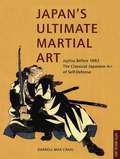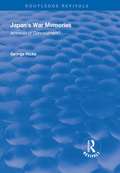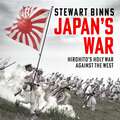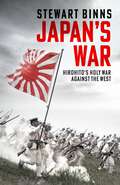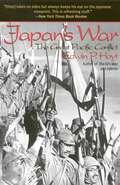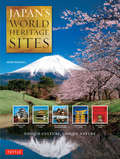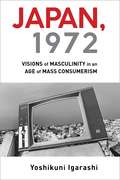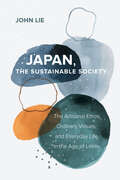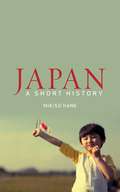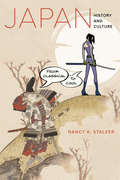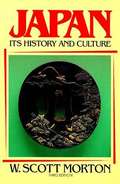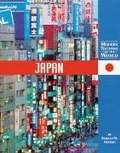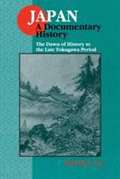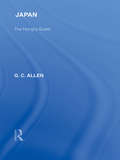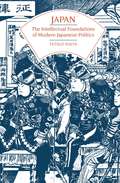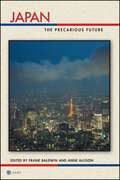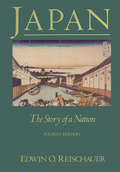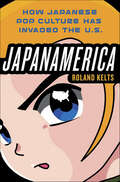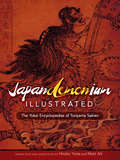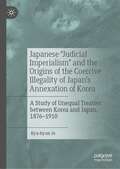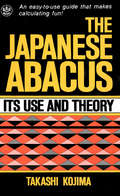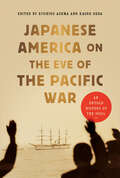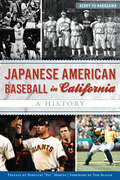- Table View
- List View
Japan's Ultimate Martial Art
by Darrell Max CraigPredecessor of Judo and precursor of today's ultimate fighting styles, Jujitsu is a martial art developed by the elite samurai class during Japan's feudal days. For centuries, this method of unarmed self-defense proved so successful in combat that it was kept secret and taught to a select few. Based on the author's study with instructors of the Tokyo police department, this book features the traditional techniques of Jujitsu, also known as Ju-Jiutsu. Chapter by chapter, it addresses and demonstrates Kaisho Goshin Budo Taiho Jitsu Ryu (Tokyo police/ self-defense/ martial way/ body techniques). Specific techniques covered include the use of hands, throwing an opponent, attacking vital points with strikes and kicks, and the use of weapons such as the staff. Though designed to accompany training, this fascinating book also serves as a remarkable illustrated guide to the secret art of samurai self-defense.
Japan's Ultimate Martial Art
by Darrell Max CraigPredecessor of Judo and precursor of today's ultimate fighting styles, Jujitsu is a martial art developed by the elite samurai class during Japan's feudal days. For centuries, this method of unarmed self-defense proved so successful in combat that it was kept secret and taught to a select few. Based on the author's study with instructors of the Tokyo police department, this book features the traditional techniques of Jujitsu, also known as Ju-Jiutsu. Chapter by chapter, it addresses and demonstrates Kaisho Goshin Budo Taiho Jitsu Ryu (Tokyo police/ self-defense/ martial way/ body techniques). Specific techniques covered include the use of hands, throwing an opponent, attacking vital points with strikes and kicks, and the use of weapons such as the staff. Though designed to accompany training, this fascinating book also serves as a remarkable illustrated guide to the secret art of samurai self-defense.
Japan's War Memories: Amnesia or Concealment? (Routledge Revivals)
by George HicksFirst published in 1997, this volume responds to attention in recent years which has been belatedly directed towards reviving World War II issues involving Japan. This study deals first with the manner in which such issues so long fell into abeyance under Cold War conditions, while tracing the vast and varied writing on the war which meanwhile appeared within Japan. Evolving Japanese views on the war are largely focused on debate over the revision of the postwar constitution, especially its renunciation of "war potential". The book also contains the first overview of the decades-long litigation within Japan on the screening of textbooks, especially on the war.
Japan's War: Hirohito’s Holy War Against the West
by Stewart Binns'A superbly revealing account of a dreadful and profoundly sad war' ALASTAIR CAMPBELL'This extraordinary book gives us a unique insight into why and how Japan fought such an appalling war' NICK HEWERA new perspective on Japan during the Asia-Pacific War, using remarkable first-hand Japanese source material.Even after eighty years since the end of a conflict that killed thirty-five million people, there remains deeply-felt bitterness and anger about the way the Asia-Pacific War was fought, especially by the Japanese. The war in the East stretched from Hawaii to India - with Japanese forces attacking Singapore, China and Malaysia, as well as bombing the north coast of Australia. The Allied forces, led by the US, waged an island-by-island counteroffensive that eventually saw the invasion of the Japanese homeland. Japan has been vilified for the countless examples of its cruelty to civilians and prisoners of war. These criticisms have led to a backlash in Japan, where many deny that the accusations are true. By going back to the origins of modern Japan, and by using only Japanese accounts, Japan's War: Hirohito's Holy War against the West offers a powerful account of the conflict and explains in detail why the Japanese conducted the war in the way that they did.
Japan's War: Hirohito’s Holy War Against the West
by Stewart Binns'A superbly revealing account of a dreadful and profoundly sad war' ALASTAIR CAMPBELL'This extraordinary book gives us a unique insight into why and how Japan fought such an appalling war' NICK HEWERA new perspective on Japan during the Asia-Pacific War, using remarkable first-hand Japanese source material.Even after eighty years since the end of a conflict that killed thirty-five million people, there remains deeply-felt bitterness and anger about the way the Asia-Pacific War was fought, especially by the Japanese. The war in the East stretched from Hawaii to India - with Japanese forces attacking Singapore, China and Malaysia, as well as bombing the north coast of Australia. The Allied forces, led by the US, waged an island-by-island counteroffensive that eventually saw the invasion of the Japanese homeland. Japan has been vilified for the countless examples of its cruelty to civilians and prisoners of war. These criticisms have led to a backlash in Japan, where many deny that the accusations are true. By going back to the origins of modern Japan, and by using only Japanese accounts, Japan's War: Hirohito's Holy War against the West offers a powerful account of the conflict and explains in detail why the Japanese conducted the war in the way that they did.
Japan's War: The Great Pacific Conflict
by Edwin P. HoytTracing the history of Japanese aggression from 1853 onward, Hoyt masterfully addresses some of the biggest questions left from the Pacific front of World War II.
Japan's World Heritage Sites
by John DougillVisit the most compelling cultural and nature sites in all of Japan!In Japan's World Heritage Sites, readers are introduced to the temples, gardens, castles and natural wonders for which Japan is so justly renowned-all of those now declared to be UNESCO World Heritage Sites. Author John Dougill describes each site in detail, stating why they were singled out by UNESCO, the current number and types of sites, the application process, how the sites have been selected, and how difficult it is to be given the special status of a World Heritage Site.Dougill traveled to all of the sites in Japan to research this book. These are without a doubt the most interesting sites that Japan has to offer, including: Mount Fuji, Japan's tallest and most sacred volcano. Himeji Castle, a monument from Japan's long feudal history. Horyu-ji Temple, the world's oldest surviving wooden structure Hiroshima Peace Memorial or Atomic-Bomb Dome The Ogasawara Islands, a remote archipelago of over 30 islands-including Iwo JimaReaders will learn how Japan first became involved with the World Heritage Sites program back in 1993, the importance of these designations, and their popularity in Japan, where they are visited by millions of people annually.
Japan, 1972: Visions of Masculinity in an Age of Mass Consumerism
by Yoshikuni IgarashiBy the early 1970s, Japan had become an affluent consumer society, riding a growing economy to widely shared prosperity. In the aftermath of the fiery political activism of 1968, the country settled down to the realization that consumer culture had taken a firm grip on Japanese society. Japan, 1972 takes an early-seventies year as a vantage point for understanding how Japanese society came to terms with cultural change.Yoshikuni Igarashi examines a broad selection of popular film, television, manga, and other media in order to analyze the ways Japanese culture grappled with this economic shift. He exposes the political underpinnings of mass culture and investigates deeper anxieties over questions of agency and masculinity. Igarashi underscores how the male-dominated culture industry strove to defend masculine identity by looking for an escape from the high-growth economy. He reads a range of cultural works that reveal perceptions of imperiled Japanese masculinity through depictions of heroes’ doomed struggles against what were seen as the stifling and feminizing effects of consumerism. Ranging from manga travelogues to war stories, yakuza films to New Left radicalism, Japan, 1972 sheds new light on a period of profound socioeconomic change and the counternarratives of masculinity that emerged to manage it.
Japan, the Sustainable Society: The Artisanal Ethos, Ordinary Virtues, and Everyday Life in the Age of Limits
by John LieBy the late twentieth century, Japan had gained worldwide attention as an economic powerhouse. Having miraculously risen from the ashes of World War II, it was seen by many as a country to be admired if not emulated. But by the early 1990s, that bubble burst in spectacular fashion. The Japanese economic miracle was over. In this book, John Lie argues that in many ways the Japan of today has the potential to be even more significant than it was four decades ago. As countries face the prospect of a world with decreasing economic growth and increasing environmental dangers, Japan offers a unique glimpse into what a viable future might look like—one in which people acknowledge the limits of the economy and environment while championing meaningful and sustainable ways of working and living. Beneath and beyond the rhetoric of growth, some Japanese are leading sustainable lives and creating a sustainable society. Though he does not prescribe a one-size-fits-all cure for the world, Lie makes the compelling case that contemporary Japanese society offers a possibility for how other nations might begin to valorize everyday life and cultivate ordinary virtues.
Japan: A Short History (Short Histories Ser.)
by Mikiso HaneWhat is a shogun? Who were the samurai and what is the warrior code? What lies behind the Japanese work ethic? From the ancient tea ceremony to the boom and subsequent downturn of its economic prosperity, this uniquely concise introduction to Japan and its history surveys nearly 10,000 years of society, culture, economics and politics. Balancing economic and political information with new insights into the twin spheres of art and religion, Mikiso Hane offers authoritative coverage of all aspects of Japanese life. With a particular focus on the key events of the last 200 years, the author also pays special attention to the changing conditions of those whose history has been so frequently neglected - the women, the peasants, and the lowest order of untouchables. Well-rounded and enlightening, this informative account of Japan and its people will be greatly appreciated by historians, students and all those with an interest in this diverse and enigmatic country.
Japan: History and Culture from Classical to Cool
by Nancy K. StalkerJapan: History and Culture from Classical to Cool provides a historical account of Japan’s elite and popular cultures from premodern to modern periods. Drawing on the most up-to-date scholarship across numerous disciplines, Nancy K. Stalker presents the key historical themes, cultural trends, and religious developments throughout Japanese history. Focusing on everyday life and ordinary consumption, this is the first textbook of its kind to explore both imperial and colonial culture and offer expanded content on issues pertaining to gender and sexuality. Organized into fourteen chronological and thematic chapters, this text explores some of the most notable and engaging aspects of Japanese life and is well suited for undergraduate classroom use.
Japan: Its History and Culture (3rd Edition)
by W. Scott MortonBeginning with its earliest known civilization (about 3,000 B.C.), Japan: Its History and Culture traces aspects of Japanese religion, art, militarism, and agriculture and analyzes the social, political, and economic life of Asia's wealthiest nation. Richly anecdotal, this book casts fascinating sidelights on significant Japanese personalities, works of literature, and historic events, and the characteristic of the Japanese culture to adopt other's material for their own.
Japan: Modern Nations of the World
by Patricia D. NetzleyThis insightful volume discusses the geography, history, and culture of Japan, emphasizing how the country's past has shaped its national identity and affected the lives of modern Japanese.
Japan: The Dawn Of History To The Late Tokugawa Period Century
by David J. LuThis compilation of primary documents presents in a clear and accessible format, with full annotation and incisive commentary by Dr. Lu, readings translated from the original Japanese that cover the full spectrum of political, economic, and diplomatic as well as cultural and intellectual history of pre-modern Japan (volume II covers the modern period).
Japan: The Hungry Guest
by G C AllenWritten after the outbreak of war between Japan and China but putting aside British sentiments of suspicion, dislike and a sense of competition, G C Allen bases his observations of Japanese social, political and economic life on his first-hand experience of living and working in the country for a number of years. He argues that the economic expansion of Japan was regarded as a greater threat to Britain because of Japan’s political aims and aggressive territorial expansion, but he is at pains to explain the Japanese domestic circumstances which gave rise to this situation. He also argues that the expansion of the British Empire has some parallels with Japanese expansion, without condoning Japanese methods. Overall the author emphasizes the extent to which judgments about the qualities of the Japanese people have been influenced by the political views of writers in Western countries.
Japan: The Intellectual Foundations of Modern Japanese Politics
by Tetsuo NajitaHistorians have long been aware of the richness and complexity of the intellectual history of modern Japanese politics. Najita's study, however, is the first in a Western language to present a consistent and broad synthesis of this subject. Najita elucidates the political dynamics of the past two hundred years of Japanese history by focusing on the interplay of restorationism and bureaucratism within the context of Japan's modern revolution, the Meiji Restoration.
Japan: The Intellectual Foundations of Modern Japanese Politics
by Tetsuo NajitaHistorians have long been aware of the richness and complexity of the intellectual history of modern Japanese politics. Najita's study, however, is the first in a Western language to present a consistent and broad synthesis of this subject. Najita elucidates the political dynamics of the past two hundred years of Japanese history by focusing on the interplay of restorationism and bureaucratism within the context of Japan's modern revolution, the Meiji Restoration.
Japan: The Precarious Future (Possible Futures #1)
by Frank Baldwin Anne AllisonOn March 11, 2011, a 9.0 earthquake off Japan’s northeast coast triggered a tsunami that killed more than 20,000 people, displaced 600,000, and caused billions of dollars in damage as well as a nuclear meltdown of three reactors at the Fukushima Daiichi nuclear plant. Japan, the world’s third largest economy, was already grappling with recovery from both its own economic recession of the 1990s and the global recession following the US-driven financial crisis of 2008 when the disaster hit, changing its fortunes yet again. This small, populous Asian nation—once thought to be a contender for the role of the world’s number one power—now faces a world of uncertainty. Japan’s economy has shrunk, China has challenged its borders, and it faces perilous demographic adjustments from decreased fertility and an aging populace, with the country’s population expected to drop to less than 100 million by 2048. In Japan: The Precarious Future, a group of distinguished scholars of Japanese economics, politics, law, and society examine the various roads that might lie ahead. Will Japan face a continued erosion of global economic and political power, particularly as China’s outlook improves exponentially? Or will it find a way to protect its status as an important player in global affairs? Contributors explore issues such as national security, political leadership, manufacturing prowess, diplomacy, population decline, and gender equality in politics and the workforce, all in an effort to chart the possible futures for Japan. Both a roadmap for change and a look at how Japan arrived at its present situation, this collection of thought-provoking analyses will be essential for understanding the current landscape and future prospects of this world power.
Japan: The Story of a Nation (Great Contemporary Issues Ser. #10)
by Edwin ReischauerIn this major revision of his classic history of Japan—from the tribally divided state under the leadership of Yamato in the fifth century through centuries of dynastic rule to the death of Emperor Hirohito in 1989—the eminent Harvard historian and former U.S. Ambassador to Japan Edwin O. Reischauer incorporates nearly a decade's worth of new scholarship. His book is divided into three parts: the first part examines traditional Japan from the early Chinese influences to the flowering of a native culture and the establishment of a feudal system and society; the second looks at Japan in transition from the beginnings of the modern state to the rise of militarism and the advent of World War II; the third section, extensively rewritten to reflect Japan's drastically changed role in world affairs since 1984, deals with postwar Japan from the American Occupation and years of political division and instability to Japan's gradual metamorphosis into an economic giant. The Nakosone and Takeshita years are discussed at length, and the transformation of Japan's economy, hinged upon surging exports to the West, is analyzed. Clear, concise, and enormously informative, Reischauer's Japan: The Story of a Nation encompasses political, social, economic, and cultural history in a superbly readbable narrative.
Japanamerica: How Japanese Pop Culture Has Invaded the U.S.
by Roland KeltsContemporary Japanese pop culture such as anime and manga (Japanese animation and comic books) is Asia's equivalent of the Harry Potter phenomenon--an overseas export that has taken America by storm. While Hollywood struggles to fill seats, Japanese anime releases are increasingly outpacing American movies in number and, more importantly, in the devotion they inspire in their fans. But just as Harry Potter is both "universal" and very English, anime is also deeply Japanese, making its popularity in the United States totally unexpected. Japanamerica is the first book that directly addresses the American experience with the Japanese pop phenomenon, covering everything from Hayao Miyazaki's epics, the burgeoning world of hentai, or violent pornographic anime, and Puffy Amiyumi, whose exploits are broadcast daily on the Cartoon Network, to literary novelist Haruki Murakami, and more. With insights from the artists, critics, readers and fans from both nations, this book is as literate as it is hip, highlighting the shared conflicts as American and Japanese pop cultures dramatically collide in the here and now.
Japandemonium Illustrated: The Yokai Encyclopedias of Toriyama Sekien
by Toriyama SekienFirst English publication of all four of Sekien's masterworks: The Illustrated Demons' Night Parade, More Illustrated Demons from Past and Present, Even More Demons from Past and Present, and An Idle Horde of Things.
Japanese "Judicial Imperialism" and the Origins of the Coercive Illegality of Japan's Annexation of Korea: A Study of Unequal Treaties between Korea and Japan, 1876–1910
by Kyu-hyun JoThis book explores the legacy of the Japanese empire in Korea, asking how colonialism arose as a legal idea. What was the legal process behind the establishment of colonialism as Japan's prime strategy towards Korea since the late 19th century? By addressing such questions, it is not only possible to address how Japanese colonialism in Korea was born, but also address how the process behind the making of colonialism as a judicial and legal project was illegal from its origination. As East Asia grapples with a new generation of power politics, these sober reflects lend an important historical context to the struggles of the present.
Japanese Abacus Use & Theory
by Takashi KojimaThe Japanese Abacus & Theory book is easy to follow, and gives the reader step-by-step directions on how to use it correctly while applying it to practical use. The imperfect numerical notation and scarcity of suitable writing materials in ancient times are presumed to have given rise to need for devices of mechanical calculation. While the definite origin of the abacus is obscure, there is some reason for believing that its earliest form reckoning table covered with sand or fine dust, in which figures were drawn with a stylus, to be erased with the figure when necessary. Though the Abacus is an older tool for calculation it still is used today in Japan taking on a different name called Soroban. Though the Japanese Abacus or Soroban may appear mysterious or even primitive to those raised in the age of pocket calculators and desktop computers, this intriguing tool is capable of amazing speed and accuracy. It is still widely used throughout the shops and markets of Asia, and its popularity shows no sign of decline. Here for the first time in English is a complete explanation of how to use the abacus.
Japanese America on the Eve of the Pacific War: An Untold History of the 1930s
by Eiichiro Azuma and Kaoru UedaThe era sandwiched between the 1924 US Immigration Act and the 1941 Japanese attack on Pearl Harbor marks an important yet largely buried period of Japanese American history. This book offers the first English translation of Yasuo Sakata's seminal essay arguing that the 1930s constitutes a chronological and conceptual "missing link" between two predominant research interests: the pre-1924 immigration exclusion and the mass incarceration of Japanese Americans during World War II. The anthology pays tribute to Sakata's role as a foremost historian of early Japanese America and transpacific migration while providing an opportunity for a younger generation of scholars to reflect on his contributions and carve out a new area of research in Japanese American history. Original and translated essays from scholars of varied backgrounds and generations explore topics from diplomacy, geopolitics, and trade to immigrant and ethnic nationalism, education, and citizenship. Together, they attempt to catalyze further research and writing based on the thorough and careful analysis of primary-source materials, an effort that Sakata spearheaded in both the United States and Japan.
Japanese American Baseball in California: A History (Sports Ser.)
by Kerry Yo NakagawaFour generations of Japanese Americans broke down racial and cultural barriers in California by playing baseball. Behind the barbed wire of concentration camps during World War II, baseball became a tonic of spiritual renewal for disenfranchised Japanese Americans who played America's pastime while illegally imprisoned. Later, it helped heal resettlement wounds in Los Angeles, San Francisco, the Central Valley and elsewhere. Today, the names of Japanese American ballplayers still resonate as their legacy continues. Mike Lum was the first Japanese American player in the Major Leagues in 1967, Lenn Sakata the first in the World Series in 1983 and Don Wakamatsu the first manager in 2008. Join Kerry Yo Nakagawa in this update of his 2001 classic as he chronicles sporting achievements that doubled as cultural benchmarks.
